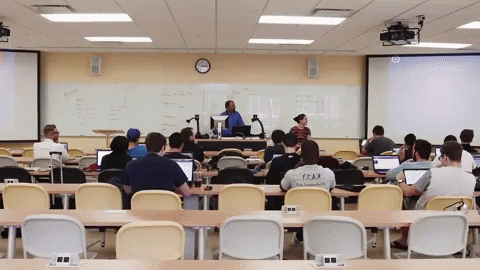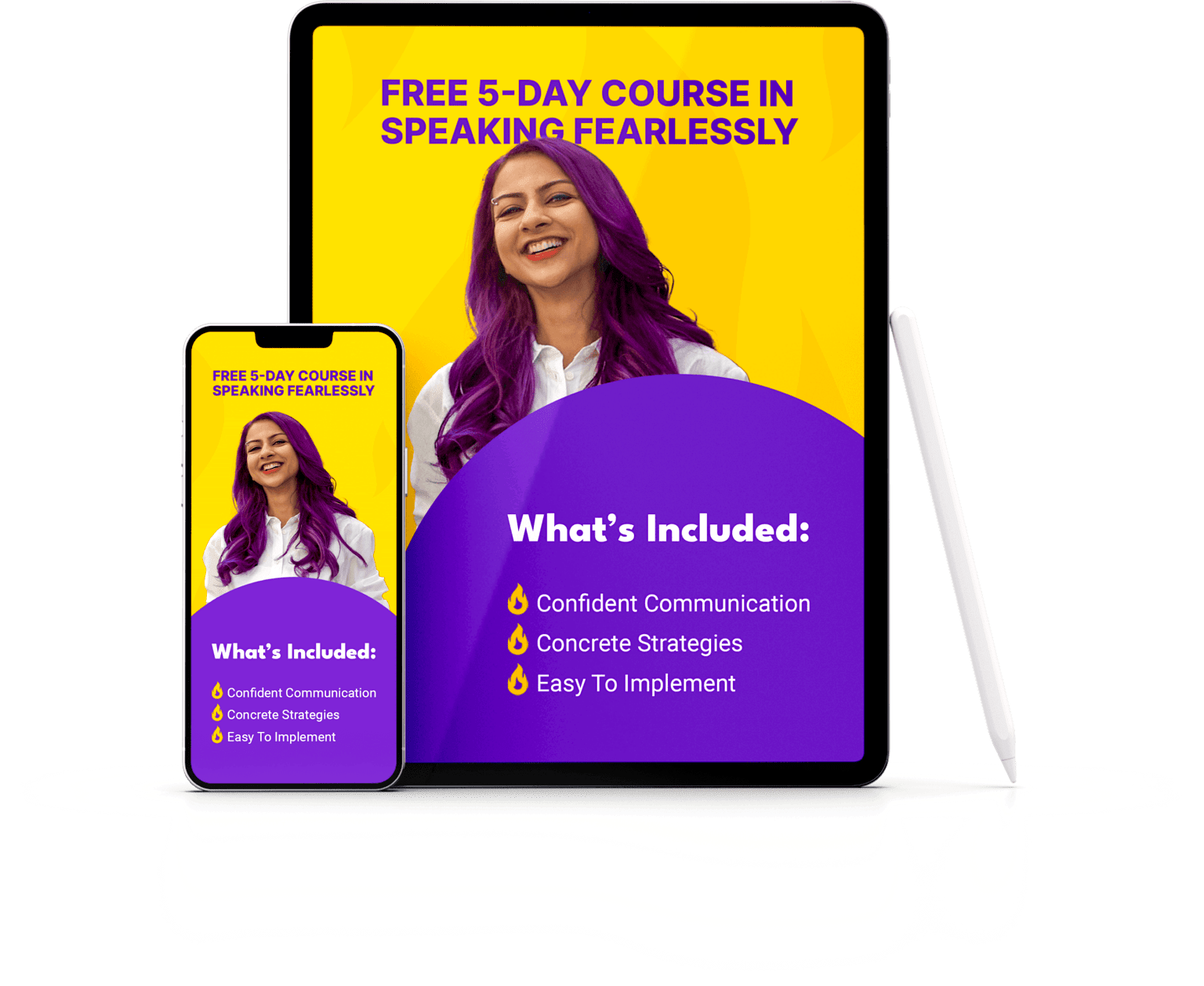Is it unusual for CEOs or entrepreneurs to enroll in a public speaking course?
Not at all! I have been coaching CEOs and execs to speak on camera and stage for 10 years. Despite their seniority and experience, these leaders often find themselves grappling with their nerves or rambling, especially when speaking to larger groups.
For some, the mere thought of speaking in public induces a paralyzing fear. Others struggle with past traumas of going blank in the spotlight that makes them dread speaking in public again. Even those who consider themselves confident feel like they can do more to connect with their audience, build their influence and give memorable talks.

Nausheen I. Chen on the TEDx stage in China
Enrolling in a public speaking course can help CEOs, entrepreneurs and executives become the most impactful voice in any room. This is crucial for them to become thought leaders in their field.
So, read on as I show you how public speaking courses work and how to choose the right one for you.
Want to learn to speak with confidence in your next presentation or podcast? Join us in the upcoming Speak as a Leader bootcamp here.
Table of Contents
Public Speaking Courses 101
Public speaking courses teach you the fundamentals to become an impactful speaker. These structured programs offer a lifeline to professionals – executives as well as entrepreneurs. They can provide a nurturing environment where the timid find their voices, the traumatized overcome their fears and the partially confident reach new levels of excellence in speaking.
However, in my experience, the wrong kind of course can be a complete waste of time and money. I’ve worked with clients who have invested thousands of dollars in “public speaking courses”. But they’ve only been taught superficial skills like standing a certain way or projecting their voice, without gaining any real understanding of how to find their true voice.
So it’s crucial to know what you can expect from these classes to ensure they’re relevant to your unique needs.

How public speaking courses work
There are three main types of public speaking courses: live cohort-based courses, DIY self-paced learning and hybrid courses that combine the two approaches. Each type offers unique advantages and approaches to learning. It’s important to understand which course format aligns best with your learning style and preferences.
1. Cohort-based Courses
Cohort-based coaching involves learning in a live group setting. Participants progress through the course together, following a structured curriculum led by a speaking coach. Cohort-based courses often include live classes, group discussions, interactive activities and assignments.
The advantage of this format is the opportunity for peer interaction and mentorship, collaboration and real-time feedback from coaches and fellow participants. It fosters a sense of community and accountability among learners.
I’ve received feedback from participants in my cohort-based program on how they enjoyed learning with their peers the most. The right group can make or break this type of course.

Here are some of the benefits of learning public speaking with a cohort:
- Collaboration and Feedback
Public speaking by definition is best practiced in “public”. Cohort-based courses offer a unique opportunity for participants to practice speaking in a safe environment. Everyone has a common goal – to become a stronger speaker – and this quickly creates a sense of community and enhances the learning experience. - Support
Cohort learning links you to a network of peers for support. Whether you want advice on your upcoming presentation, or feedback on how you did, your cohort is readily available. Additionally, you can rely on your cohort for encouragement whenever necessary.
- Networking
Being in a cohort provides opportunities to expand your network and forge connections more effortlessly. Very often, my cohort-based clients end up working with each other as they get to know each other intimately over the space of a few weeks.
Do you enjoy learning with a group of like-minded people? Check out the upcoming Speak as a Leader bootcamp where I personally coach small groups of 10-15 execs and entrepreneurs and enable them to become powerful speakers.
2. Self-paced learning (DIY)
Self-paced, or DIY learning, means you go through the course at your own speed.
Participants can access pre-recorded lessons, instructional materials and complete assignments at their own pace and convenience. There are no fixed deadlines and lower accountability.
While self-paced courses offer flexibility, they may lack the interactive elements and real-time feedback that you find in cohort-based courses. However, they could be the only solution for some executives and entrepreneurs with busy schedules. It allows them to study whenever they find the time, making it easier to manage their schedules.

Here are some benefits of learning public speaking skills at your own pace:
- Convenience
The main advantage of self-paced learning programs is their convenience. You can study whenever it fits into your schedule, whether you prefer early mornings or late nights, allowing you to utilize your time effectively.
- Flexibility
On-demand courses provide flexibility tailored to your learning pace. If you require additional time to grasp course content, you have the freedom to take it. For instance, if you find a particular lesson challenging, on-demand learning permits you to invest as much time as necessary to comprehend the material and practice strategically.
Alternatively, there are occasions when you might prefer to move swiftly through course material. If you are generally quick at learning, you’re not obliged to wait for others in a self-paced program. You can progress through the material efficiently at your own pace.
However, I’d like to share a watch-out here: In my experience, public speaking is not a skill you can learn without interaction, guidance or feedback from others. You could grasp the basics of how to use your voice and body language – but without feedback from your peers or a coach, it’s difficult to tell whether you’re using the techniques well.
3. Hybrid Courses
Hybrid courses combine elements of cohort-based and self-paced learning formats. Participants may engage in live sessions with instructors and peers at scheduled times while also accessing pre-recorded lessons and materials for self-study.
Hybrid courses offer a balance between structure and flexibility, allowing learners to benefit from both real-time interaction as well as independent learning.

These are some of the benefits that you get from hybrid public speaking courses:
- Flexibility
Hybrid courses allow learners to access course materials and lectures at their own pace, offering flexibility for those with busy schedules or other commitments. Participants can engage with course content at convenient times while still having opportunities for real-time interaction during live learning sessions.
- Customized learning experience
Hybrid courses cater to diverse learning styles and preferences. Learners can choose to participate in live sessions for immediate feedback and interaction or engage in self-paced study to spend more time on different topics at their own pace.
- Balanced Structure
Hybrid courses strike a balance between structure and autonomy, providing learners with a framework while also empowering them to take ownership of their progress. This format ensures that participants receive guidance and support from coaches while fostering independence and self-paced learning.

What you learn in public speaking courses
Throughout the course, participants will learn various essential topics that will transform them into a public speaker that can influence and will be remembered even after their presentation.

Naushen Chen speaking on Tedx stage
Here’s what a typical public speaking course would cover:
- Managing nervousness and performance anxiety
Many people consider public speaking to be one of the most dreaded situations they can encounter. The fear of addressing a large audience can significantly impact your ability to articulate your thoughts. Overcoming this fear involves overcoming the fears you associate with speaking in public, as well as learning how to improve your speaking skills.
Public speaking courses often include techniques for managing anxiety, such as deep breathing exercises, visualization and cognitive restructuring, to help participants stay calm and focused during presentations. - Strategies for organizing your talk or presentation effectively
Most public speaking courses will teach you the skills needed to prepare engaging presentations and talks. - Strategies for engaging your audience
The goal is to deliver a memorable presentation or speak on a podcast so everyone remembers you. Establishing a connection with the audience is crucial. These courses teach you how to use storytelling, humor and rhetorical devices in your talk or interview. - Guidance on vocal variety to enhance your delivery
Learning to use your voice effectively is key in public speaking. When you vary your pitch, tone, volume and pace, you engage the audience more effectively. The way you enunciate and use pauses can make or break your message.
- Feedback on body language and nonverbal communication
It’s crucial to understand how to use your body language effectively when you speak – either on camera or on a stage. Being able to influence how your message is received by the audience is key to becoming a thought leader. - Training on how to effectively use visual aids
Visual aids help engage the audience, clarify complex information and make your presentation more memorable. Learning to use them effectively is essential for delivering impactful presentations. - Opportunities for practice and feedback
In-class presentations and peer evaluations provide opportunities for participants to apply what they’ve learned, receive constructive feedback and refine their speaking abilities. By practicing regularly and receiving feedback from peers and coaches, learners can improve their confidence, delivery and overall effectiveness as public speakers.
These are highly needed skills that will improve your ability to communicate effectively whether it’s a one-on-one conversation or in front of an audience.
Do public speaking courses help?
Public speaking, unlike finance, is not something that you can just impart in a one-way lecture or a one-way course. It’s not just information that you need to understand.
It includes actionable strategies that you need to implement with guidance and feedback. That’s why the best public speaking courses are interactive, collaborative and include live guidance.
A well-designed public speaking course doesn’t just focus on speaking mannerisms. It helps participants dive deeper into learning how to be confident on the inside as well.
How do public speaking courses ensure they’re effective?
- Structured Learning
A well-designed public speaking course provides a structured environment for learning and practicing speaking skills. The curriculum is designed by experienced coaches who understand the principles of effective communication. - Practice and Feedback
The best courses offer a lot of opportunities for participants to practice speaking in front of others. Regular practice, coupled with constructive feedback from your coach and peers, allows you to identify areas for improvement and make tangible progress over time. - Confidence Building
One of the primary benefits of public speaking courses is the confidence they instill in participants. As they gain experience and receive positive reinforcement from their peers and coaches, shy participants often become more comfortable and confident when speaking in front of others.

Who are they for?
Public speaking courses are for you if you are:
- An executive who wants to improve how to present to senior management to fast-track your career growth.
- An entrepreneur or founder who wants to be seen as an expert any time you speak on a podcast or call.
- A consultant or entrepreneur who regularly delivers presentations or creates course videos. Public speaking classes typically cover skills like improving vocal variety, body language and storytelling. These help participants become more engaging and effective communicators.
- A speaker who is somewhat confident but feel you haven’t reached your full potential. Public speaking classes offer opportunities for refinement of your speaking skill set. Advanced techniques, personalized feedback and challenging exercises push participants to stretch beyond their comfort zones and reach new levels of proficiency.
Watch-out: If you’re a very shy and timid person who is overwhelmed by having to speak when you’re under the spotlight, I would recommend one-on-one coaching. Jumping straight into the deep end with a group-based course might be too overwhelming for you.
Individuals who have had traumatic experiences speaking in public may find it difficult to be in the spotlight again due to triggers or anxiety. One-on-one coaching led by experienced trainers can help create a safe space for participants to work through their challenges at their own pace.

Image by wavebreakmedia_micro on Freepik
Top 7 Public Speaking Courses
- Dale Carnegie Training: Effective Communication and Human Relations
This course is the instructor-led live online version of the famous Dale Carnegie Course®. It seems to be great for boosting your confidence and skills at work or even in personal life. You’ll learn how to feel more confident and effective when you present. - Toastmasters International: Public Speaking and Leadership Program
Toastmasters’ education programs are great for improving public speaking, communication and leadership. You will be able to practice regularly in a safe and supportive environment. Their curriculum has helped many introverts and shy folks achieve their public speaking goals.
I’ve attended several Toastmasters sessions in France – and in French (my third language) – and I can vouch for their friendliness and support. - Harvard University’s Free Online Course on Public Speaking
This free course is an introduction to the theory and practice of rhetoric, the art of persuasive writing and speech.
It seems to be a good fit for anyone who wants to analyze and apply rhetorical structure and style. By the end of the course, you’ll be able to apply the principles of persuasive communication in your own life, understand how to persuade and recognize when someone is trying to persuade you.
It might be a bit academic – but should give you a good grasp of the basics! - Yale’s PitchVantage Studio for Public Speaking
Yale University’s PitchVantage seems to be a helpful tool for improving public speaking skills. It lets you practice your presentation at a time that works for you. As you speak, a virtual audience gives feedback in real time. After that, you will receive more feedback on various aspects of your delivery. This course is free if you have a Yale netID. - Nano Tips to Overcome your Fear of Public Speaking With Nausheen Chen
This is my free LinkedIn Learning course where I share quick tips for speaking in public. Whether you’re speaking on stage in front of a large group, or presenting online or on camera, this course helps you speak clearly, confidently and fearlessly.
You can subscribe to LinkedIn Learning and get full access to all videos, exercise files and certificates. You can avail of a one-month free trial. It’s self-paced learning so you can accelerate at your own speed. - TED Masterclass: TED’s official guide to public speaking
TED‘s official public speaking course will help you identify, develop and share your best ideas with the world. You can find this course on YouTube, split into 11 videos. You’ll learn from experts in a structured way and can connect with other learners too.
The first lesson is free to try and you can preview all lessons before deciding to purchase. - University of Houston’s Fundamentals of Public Speaking Lectures
This course at the University of Houston refines students’ listening and verbal/non-verbal skills, essential to effective communication. This is a free YouTube-based self-paced course with on-demand videos.

How to choose a public speaking course that’s right for you
In choosing a public speaking course, you need to consider critical factors to ensure that you find the right fit for your needs and learning style. With a multitude of options available, from cohort-based classes to self-paced learning formats, navigating the course selection process can be daunting.
However, by taking the time to evaluate your goals, learning preferences and desired level of support, you can make an informed decision that sets you on the path to becoming a confident and effective public speaker.
Here’s a guide to selecting the course that could be ‘the one’ for you:
1. Identify Your Challenges
Take stock of your speaking challenges, whether they stem from shyness, past traumas, performance anxiety or a lack of confidence. Understanding your specific hurdles will guide you in selecting a course that addresses them effectively.
2. Clarify Your Priorities
Determine your goals and priorities for taking a public speaking course. Are you seeking to overcome fear, improve communication skills, enhance career prospects or something else? From all the challenges that you identified in the first step, which one can you overcome to help you move the needle the most in your career or business?
Ensure that the course modules and material cover what you need to understand and learn the most. .
3. Define What You Don’t Want
Consider what you don’t want in a course. Reflect on whether you want to be in overly competitive environments, with rigid teaching methods or lack of individualized attention. When you identify deal-breakers upfront, you can narrow down your options and save yourself time and frustration.
People very often attach value to the Harvard or Yale brand name. But ensure that you understand whether or not the course will be personalized enough, small enough or interactive enough for you to learn well.
4. Consider Your Preferred Learning Style
Reflect on how you learn best. Do you thrive in interactive group settings, prefer one-on-one coaching or excel in self-paced online modules? Choose a course format that caters to your preferred learning style to maximize engagement and effectiveness.
In my experience, public speaking is very difficult to learn by yourself without feedback.
So even if you are a self-starter, you should still consider joining a community or being part of a live or a test environment where you can speak to an audience.
5. Evaluate Your Preferred Support System
Assess the level of support you desire throughout the course. Are you looking for a supportive community of peers, personalized feedback from instructors or additional resources for practice and reinforcement? Opt for a course that offers the support system you need to stay motivated and accountable.

Image by rawpixel.com on Freepik
By considering these factors and conducting thorough research, you can select a public speaking course that not only addresses your challenges but also aligns with your priorities, learning style and support preferences. Remember to review course testimonials, syllabi and instructor credentials to ensure a good fit before making your decision.
5 Things I Am Going To Include In My Public Speaking Course
In my public speaking course, I’m going to include these five critical elements to help you speak confidently.
1. Deep dive into confidence
In my public speaking course, I’ll make sure that we don’t just focus on the performative aspect of public speaking. We’ll dive deeper into why you feel unsure or have mental blocks that stop you from being an outstanding speaker. I don’t want you to just fake confidence without really feeling it on the inside when you speak.
2. Actionable tools and strategies
I’ll give you practical techniques that focus on how you use your voice, energy and body language when you speak.
Whether you are talking to a live audience or recording a video to be shared later, you can use your speaking style to be understood, make an impact and be remembered.
I will share proven strategies to help you maximize every public speaking opportunity.
3. Feedback system
This is the key to exponentially getting better.
I would include a feedback element where you’ll have the opportunity to record yourself practicing speaking and receive feedback from me.
This feedback loop is crucial for your improvement as it allows you to identify areas for growth and refine your skills over time. By reviewing your recordings and incorporating constructive feedback, you’ll experience significant growth in your speaking abilities, gradually becoming a more confident and impactful speaker.
4. A safe environment
In our community, you can share your ideas and practice speaking freely. You’ll receive feedback from both me and your peers, creating a supportive environment for improvement. This will really simulate that live public speaking experience.
5. Master the art of prepared and improvised speaking
We’ll focus on delivering well-rehearsed presentations and also on handling impromptu situations, like Q&A sessions, podcasts or live events, where you need to speak spontaneously. I’ll use exercises from my improv experience to help you get better at thinking on your feet and articulating your thoughts on the spot. The goal is to ensure that you’re always ready!
Conclusion
As a public speaking coach, I’ve found that public speaking courses can be a hit or a miss. The best ones are designed to nurture your confidence, sharpen your clarity and enhance your overall communication skills. However, one-way lectures can be unhelpful and demotivating.
I hope this guide helps you choose a course that delivers on exactly what you need to thrive as an impactful public speaker.
If you’d like to work with me, we have spots open on the next Speak as a Leader Bootcamp. I’d be honored to work with you.



